Understanding the Lombard Effect for Mandarin: Relation Between Speech Recognition Thresholds and Acoustic Parameters
- PMID: 40129406
- PMCID: PMC11938858
- DOI: 10.1177/23312165251324266
Understanding the Lombard Effect for Mandarin: Relation Between Speech Recognition Thresholds and Acoustic Parameters
Abstract
The present work quantifies the Lombard effect across native speakers of Mandarin Chinese using the Matrix sentence test, which is optimized for precisely assessing speech recognition thresholds (SRTs) in noise. Specifically, we studied the effects of speaker gender, fundamental frequency (F0), formant frequencies (F1 and F2), the duration and rate of voiced segments, and frequency-specific energy redistribution characterized by alpha ratio and speech-weighted signal-to-noise ratio (swSNR) on the recognition of Mandarin in plain and Lombard speech. The Mandarin Chinese matrix test was recorded with plain and Lombard speech from 11 native-Mandarin speakers. SRTs in stationary noise were measured with native-Mandarin, normal-hearing listeners. Results showed that on average, Mandarin Lombard speech was more intelligible than Mandarin plain speech for both female and male speakers, and the Mandarin Lombard gain of female speakers was larger than that of males. In addition, various acoustic analyses involving all speakers showed that (a) only swSNR was significantly correlated with the SRT of the Mandarin plain speech; (b) most acoustic measures were significantly correlated with the SRT of the Mandarin Lombard speech; and (c) alpha ratio and swSNR were significantly correlated with the SRT Lombard gain. In addition, a gender effect was found in the correlational analysis between acoustic parameters and SRT as well as Lombard gain in SRT. The findings highlight the impact of increased high-frequency energy on the observed Lombard gain in Mandarin speech, whereas the changes in individual acoustic parameters (e.g., F0 and F1) appear to play only a minor role.
Keywords: Lombard effect; SRT Lombard gain; alpha ratio; speech recognition threshold; speech-weighted signal-to-noise ratio (swSNR).
Conflict of interest statement
Conflicting InterestsThe authors declared no potential conflicts of interest with respect to the research, authorship, and/or publication of this article.
Figures




Similar articles
-
Construction and evaluation of the Mandarin Chinese matrix (CMNmatrix) sentence test for the assessment of speech recognition in noise.Int J Audiol. 2018 Nov;57(11):838-850. doi: 10.1080/14992027.2018.1483083. Epub 2018 Sep 4. Int J Audiol. 2018. PMID: 30178681
-
Talker- and language-specific effects on speech intelligibility in noise assessed with bilingual talkers: Which language is more robust against noise and reverberation?Int J Audiol. 2015;54 Suppl 2:23-34. doi: 10.3109/14992027.2015.1088174. Epub 2015 Oct 21. Int J Audiol. 2015. PMID: 26486466
-
Influence of noise type on speech reception thresholds across four languages measured with matrix sentence tests.Int J Audiol. 2015;54 Suppl 2:62-70. doi: 10.3109/14992027.2015.1046502. Epub 2015 Jun 22. Int J Audiol. 2015. PMID: 26097982
-
The extended speech reception threshold model: Predicting speech intelligibility in different types of non-stationary noise in hearing-impaired listeners.J Acoust Soc Am. 2025 Feb 1;157(2):1500-1511. doi: 10.1121/10.0035833. J Acoust Soc Am. 2025. PMID: 40014482
-
The multilingual matrix test: Principles, applications, and comparison across languages: A review.Int J Audiol. 2015;54 Suppl 2:3-16. doi: 10.3109/14992027.2015.1020971. Epub 2015 Sep 18. Int J Audiol. 2015. PMID: 26383182 Review.
References
-
- Akeroyd M. A., Arlinger S., Bentler R. A., Boothroyd A., Dillier N., Dreschler W. A., Gagné J., Lutman M., Wouters J., Wong L., Kollmeier B. (2015). International collegium of rehabilitative audiology (ICRA) recommendations for the construction of multilingual speech tests. International Journal of Audiology, 54(Suppl. 2), 17–22. 10.3109/14992027.2015.1030513 - DOI - PubMed
-
- ANSI. (1997). American National Standard Methods for the calculation of the speech intelligibility index. American National Standards Institute.
Publication types
MeSH terms
LinkOut - more resources
Full Text Sources
Miscellaneous

